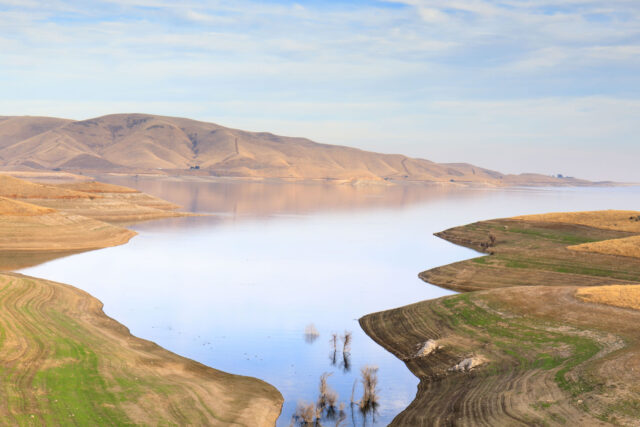New groundwater agencies in the Sacramento Valley are currently finalizing plans to manage their groundwater basins for long-term balance, as required by the Sustainable Groundwater Management Act (SGMA). Successful stewardship demands good information not only about groundwater conditions, but also about surface water availability. To help build shared understanding of surface water for agriculture—the valley’s main water-using sector—we produced a new dataset showing how access to this vital resource varies across irrigated farmland in the Sacramento Valley and the Delta. This effort builds on previous PPIC work in the San Joaquin Valley, making it now possible to assess surface water conditions across the entire Central Valley.
Although the Sacramento Valley is currently mired in extreme drought, higher precipitation and the presence of major rivers mean that its basins tend to replenish more readily and recover more quickly after drought. Nonetheless, SGMA implementation here will likely entail some pumping cutbacks to avoid significant undesirable results of groundwater use. As in the San Joaquin Valley, some areas face heightened risks of drinking water wells going dry when pumping causes groundwater levels to fall. Because the Sacramento Valley’s basins are relatively healthy, the region will need to pay greater attention to avoiding impacts of pumping on river flows, which can adversely affect downstream water users, including the environment.
Sacramento Valley surface water is spread unevenly
The water rights and contracts held by a water district determine the amount of surface water available to its growers. The interactive map below illustrates average surface water availability from various federal, state, and local projects. Districts with less than 3 acre-feet (af) per acre regularly require supplemental groundwater; those with much less are fundamentally reliant on pumping. The valley-wide average is approximately 2 af/acre, but individual district access ranges from over 6 af/acre to none.
Substantial variation arises both across basins (Vina averages less than 0.5 af/acre, versus more than 3.5 af/acre in Butte) and within (for example, Sutter and Colusa basins contain both areas rich in surface water, and areas without any). We found similar patterns of haves and have-nots within the San Joaquin Valley.
Diversity in water availability and cropping patterns creates incentives for water trading
The Central Valley also has a wide diversity of crops, and cutting back on pumping will be more costly for some crops than for others. Trading water—both within and across basins—can help lessen private and regional economic losses by keeping the most productive lands irrigated. Such trading already helps farmers manage the costs of surface water cutbacks during droughts, and incentives to trade will grow as SGMA limits groundwater availability.
Within the Sacramento Valley, water trading will be especially valuable for the large areas of high-earning perennial orchards—such as almonds, walnuts, or grapes—that have insufficient surface water but cannot be fallowed like annual crops. Approximately 70% of perennial crop acreage in the Sacramento Valley averages less than 2 af/acre of surface water; nearly 60% is on lands relying almost entirely on groundwater. Other lands may have water to trade, including those where rice is grown, helping to avoid very costly shortfalls for perennial farmers in the future.
There will also be demand for Sacramento Valley surface water beyond basin boundaries—or outside of the region altogether. The San Joaquin Valley has almost three times as much perennial crop acreage in groundwater-reliant areas. For the past three decades, Sacramento Valley growers have routinely sold water to San Joaquin Valley farmers and coastal urban communities during droughts. SGMA implementation will increase this demand, but it could also increase local pressure to keep this water at home, to balance local basins.
Although groundwater conditions are generally strong in the Sacramento Valley, the fact remains that 60% of all agricultural lands are in areas with average surface supplies below 3 af/acre. Farmers will need to adapt as groundwater becomes scarcer, especially during drought. Trading can help facilitate this adaptation. A new PPIC report on this topic identifies key barriers to water trading and explores innovative new approaches, such as expanded groundwater banking arrangements.
Note: This research was supported with a grant from the Water Foundation. The underlying data and additional notes on surface water availability in the valley can be found in Data Set: PPIC Sacramento Valley and Delta Surface Water Availability.







